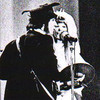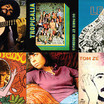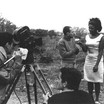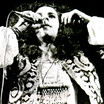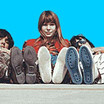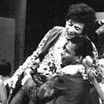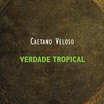Ruídos pulsativos

Musical Heirs
TROPICÁLIA, HERITAGE & HEIRS
Antonio Risério
Reminding ourselves of Memos by Augusto de Campos – poem in which the cuts and the variation of the typefaces stylizes, so to speak, memory’s labyrinthian game – we could say that Tropicália was a certain “light-instant” in the Brazilian popular music history. Not a bright and steady light as João Gilberto’s. But a “light-instant” made of many lights, chaotic, colored, multi-sparkling around the core of that thinking, which articulated itself by tracing a crossroad to converge Oswald de Andrade and the above mentioned João.
The Tropicália blossomed projecting the obvious: syncretic aesthetics for a syncretic country, in which any pretension of cultural “purity” has never been more than a poor and impoverishing alienated fantasy, astronomically distant from the real movement of our lives. In conjunctural terms, though, that “obvious” was explosive. Revolutionary. Some kind of anarchic, “brutal” and aggressive anamnesis of the Brazilian culture. At that moment, apart from Augusto de Campos and a few others, the Brazilian poetic-musical production was seen through the distorted lenses of a manichaeism anchored on ignorance. On one hand, the “good”: the authentic “national” music, multiplying agrarian protests, with a “Northeastern” form. On the other, the “evil”: rock, ballads, electric guitars, the urban “iê-iê-iê” of the so-called Jovem Guarda. It was, then, a question of establishing a cordon sanitaire between one thing and the other. Yet Tropicália came out and by simultaneously mobilizing our tradition and the modern international music, in order to grasp the Brazilian present moment, exposed this low and closed horizon.
Showing what it was all about, in its rapid and fulgurate charge (1967-1968), Tropicália had to explicit, even if fragmentarily, its view of our musical past. And, then, two things came forward: on one side of the question, the so-called “Bahian group” underlined that bossa nova had been born by establishing a formal creative dialogue between the language of samba and the international contemporaneous musical language, the jazz,; on the other, Caetano and his comrades, in tune with Oswaldian poetry, treated their antecessors with love and humor.
Taking a good look at things, we see that “nationalism” had no room. For a very simple reason: music was not born in Brazil. Actually, our production was born exactly from the immersion in extra-Brazilian languages in our ecosocial circumstance. That is what we see in Gregório de Matos’s tropical baroque. Boca do Inferno’s hybrid satire was a product of the dialectic between international aesthetics – the baroque, settled in the Iberian and Italian peninsulas – and our tropical reality under Portuguese domain, shaping itself, at that time, as a new anthropologic world.
Let us now take a look at samba. The rhythm and dance which were to shape the Recôncavo Baiano’s samba-de-roda came from the bantos. Kasadi wa Mukuma recognized its Angolan origin. And the fact that African music crossed the Atlantic was an event of profound cultural consequences. When African and European musical forms got in touch with each-other in our tropics, this encounter generated a new product, original in relation to its matrix. And, as time went by, the hybridization of African rhythm patterns with harmonic-melodic European models, the musical area that one day was to give birth to a poet-composer such as Caymmi started to be formed.
Moreover, as I have mentioned, the Tropicalistas treated their antecessors with love and humor. Tropicália refutes a legend largely heralded among university professors and literary critics: that the younger artistic generations come out necessarily denying the previous one. Yes – because the Tropicalista invention, besides calling itself João Gilberto’s ‘daughter’, never despised or was hostile to the Brazilian popular musical tradition. Much on the contrary. The denial arose within the same generation, through contrasts and clashes between the “Bahian” group and the academic left-wing from the “CPC” (popular cultural center of UNE – a student’s movement). It figures. Centered in the urban-industrial life, the Tropicalista own project, besides demolishing “leftphrenics’” (neologism, joining the words leftist and schizophrenic) blockages, causing predictable reactions, was in itself, by its own ambitious disposition, comprising the extremes of sophistication and vulgarity, something incomprehensible to an academic midcult group who would constitute, in the form of a “revolutionary hymn,” a kitsch valsinha (waltz)by a mediocre composer.
If Tropicália treated their antecessors well, apart from dishonorable exceptions, the movement was equally very well treated by the post-Tropicalista generations. Actually, one could already recognize Tropicalismo’s influxes and effects in the Brazilian musical environment during the period in which Caetano and Gil were exiled in London. We watched, then, the end of the absurd stigmatization against the electric guitar, the end of the precaution against the aestheticism of urban scenes and scenarios. There was, at last, some sort of total liberation, rejecting the boundary stakes that would somehow demarcate the place where the popular Brazilian music should clear its lands and pitch its tents.
Almost inevitably, we also had some dilution at that time: the superficial appropriation of the Tropicalista’s textual style, instead of the assimilation of the information which gave sense and substance to the movement. And so we had the bleached sub-Tropicalismo of mustangues cor de sangue, tambores da paz, sons livres, américas do sul, lixos ocidentais* (*those are extracts from some Brazilian songs’ lyrics). There was also the tristetropical (sad-tropical) counter-culture, the so-called “desbunde” (wildness) – and with this psychosocial tide of cannabis-lysergic sparkles comes an album like Ferro na Boneca, by the Novos Baianos group. Things had really changed. And that is exactly why a rock singer like Raul Seixas, who had been out of the System, could find a favorable aesthetic-cultural ecology to the flourishing of his “craziness,” as people used to say.
Right after, Tropicália’s most experimental phase would emphatically reverberate in Walter Franco’s creations. Walter Franco went towards the light of the most radical elements Tropicália mobilized: Concrete Poetry and the Brazilian musical electronic avant-garde, formed under signs of Boulez and Stockhausen. I am obviously speaking about the Walter of Cabeça, Me Deixe Mudo, Iara. Afterwards, we run into Arrigo Barnabé’s brutal and sharpened boldness of Clara Crocodilo, a work that had its way cleared by, among other things but more directly, Caetano’s Araçá Azul and by Walter’s mosca record. At last, still in connection to Tropicalismo’s open arch, we come to Arnaldo Antunes’s multi-media generation, to Chico Science’s eco-electronic mangue-beat, to the fusion and confusion promoted by the peculiar Carlinhos Brown. They are all Tropicália’s descendants. Not only Tropicália’s, obviously. But the fact is that we can recognize Tropicalismo’s undeletable tattoos in each of their poetical fields.
In very generic terms, we can say that Tropicália was a moment in which we expanded horizons and granted formal liberty to Brazilian popular music. A moment of critical and creative incorporation of the international information, of the carnavalesque syncretism between these international information and the Brazilian music’s traditional genres, such as the baião. Moment of free circulation between the poles of high culture, popular culture and mass culture. It is through the ways and non-ways of these tentative fields and boarders that Tropicáliá’s heritage moves – and its legacy un-finishes.
Exclusive for Tropicalia website.






